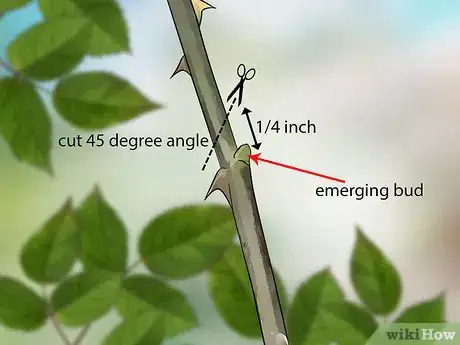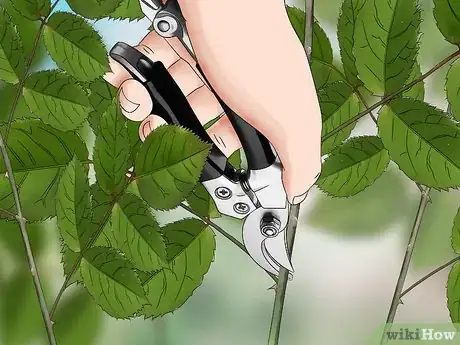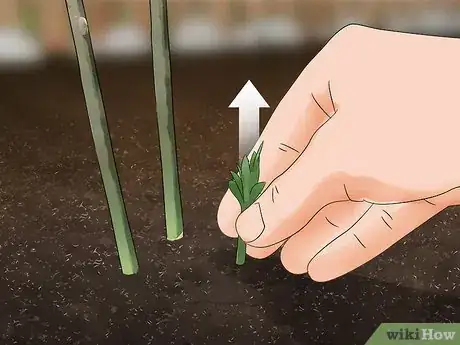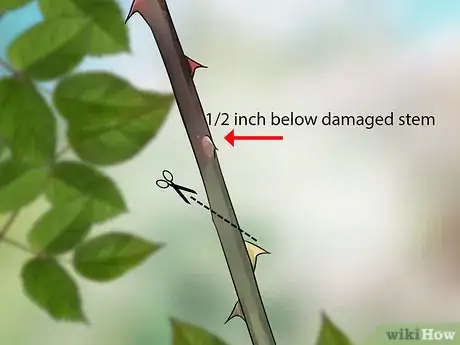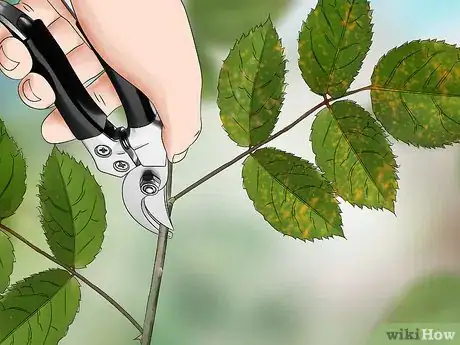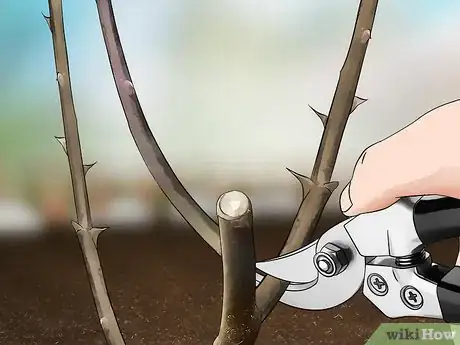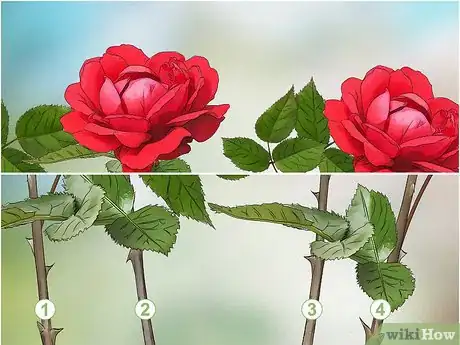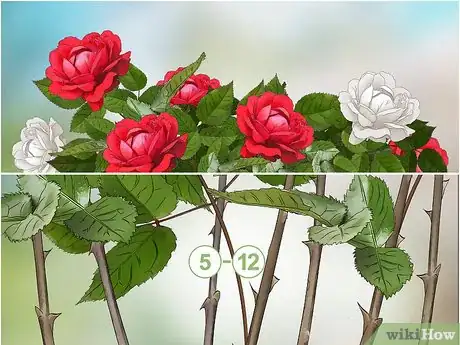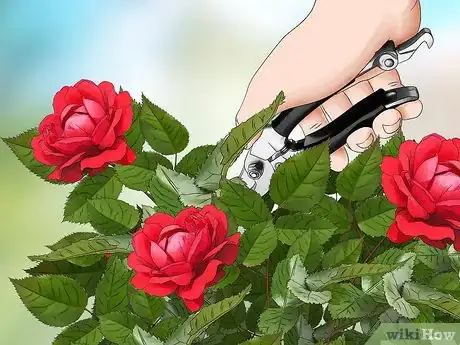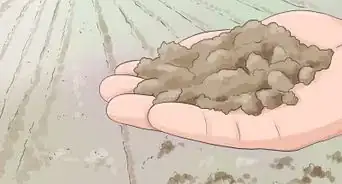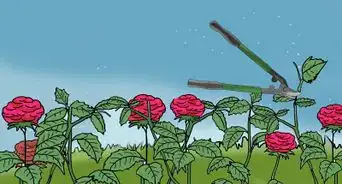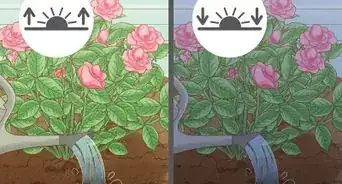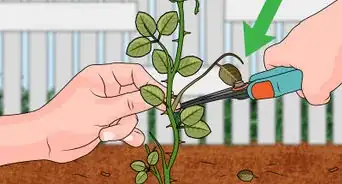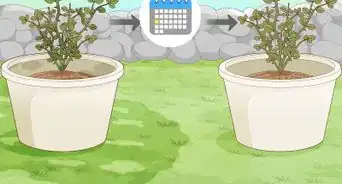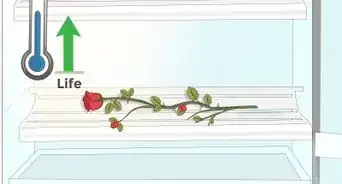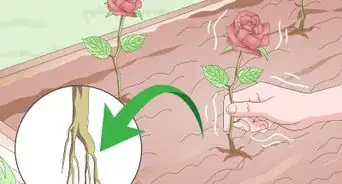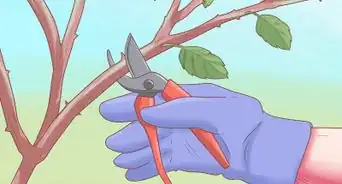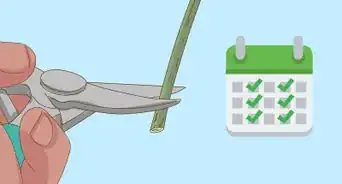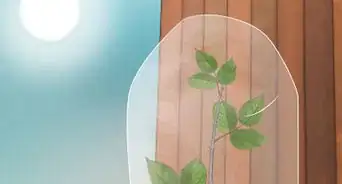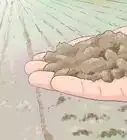This article was co-authored by Clark Hill. Clark Hill is a Plant Specialist and the Vice President of Operations at Platt Hill Nursery, a garden center and nursery based in the Chicagoland area of Illinois. Clark and the Platt Hill Nursery plant experts are committed to educating others about plants and providing advice to plant owners. Platt Hill Nursery aims to make gardening an easy and sustainable activity for everybody.
wikiHow marks an article as reader-approved once it receives enough positive feedback. In this case, 95% of readers who voted found the article helpful, earning it our reader-approved status.
This article has been viewed 84,640 times.
Rose bushes will begin to blossom in the early parts of spring. In order to make sure that the rose bushes are in good condition and will grow in the ways and directions that you’d like them to, it’s a smart idea to prune your roses late in the winter.[1] When pruning, focus on removing old wood that died during the winter or that looks unhealthy. You can also cut back roses to a greater or lesser extent based on how you’d like the rose bush to grow.
Steps
Pruning to Keep Roses Healthy
-
1Cut branches at a 45-degree angle right above the buds. Any pruning cut should be made within 1⁄4 inch (0.64 cm) above an emerging rose bud. Cutting the rose branch at an angle near a bud will prevent water from collecting on the top of the cut.[2] [3]
- The main tool you’ll use for snipping off rose branches is a pair of pruning shears, curved on both edges.
- If you’re pruning thick stems near the center of the rose bush, use a long pruning saw or lopping shears, depending on how far you need to reach to make the cut.
-
2Remove extra branches that are crowding the bush’s center. One of the primary goals in pruning rose bushes is to remove any extraneous branches and stems from the bush that could impede the flow of air. Cut off branches until you can see through from 1 side of the bush to the other with relatively few branches in your way.[4]
- A rose bush that is gnarled and choked will have a poor air supply at its center. Consequently, the branches and buds in the middle of the bush won’t grow.
Advertisement -
3Tear off suckers at the root with your hands. Suckers are small, unwanted rose growths which graft on to the roots of large, established rose bushes. If left to grow, suckers will drain away nutrients from the rose bushes. If you notice a sucker at the base of a plant, dig down through the soil until you find the place where the sucker has grafted onto the root.[5]
- In most cases, you can use your hand to tear off the small suckers from the roots of rose bushes. If the suckers are more than 1⁄8 inch (0.32 cm), though, you may need to use the shears to cut them off.
-
4Cut damaged branches 1⁄2 inch (1.3 cm) below the damaged area. Rose branches can be easily damaged during the winter by animals or people running into the bush or by winter winds snapping off branches. If you see any stems that are damaged, prune the stem.[6] This applies whether the damaged branch is almost entirely severed already, or just slightly cracked.[7]
- If damaged areas are not cut, they often lead to diseased branches.
-
5Remove discolored branches with open lesions. Branches with lesions or discoloration are a clear sign of disease.[8] The diseases that afflict most types of rose bushes are fungal, so you may notice patches of what looks like mildew creeping down the rose stems, or a red-mottled color on the stalk. Trim the rose stem at least 1⁄2 inch (1.3 cm) below diseased tissue.[9]
- After trimming potentially diseased branches, it’s important to sterilize your pruning shears. Do this by spraying the blades with a household cleaner like Lysol, or by dipping the blades in isopropyl alcohol.[10]
- While pruning for dead and diseased branches can be done at any time of year, it’s especially important to do during winter, before rose bushes “wake up” and begin to grow.
Pruning to Keep Roses Looking Beautiful
-
1Cut off dead wood in a cold-weather climate. If you live in a cold climate, your choices for maintaining the appearance of a rose bush are limited. Simply cut away all of the dead wood that has died over the winter. This will open up the rose bush, and allow air to be drawn all the way into the bush, leading to better growth during the spring.[11]
- Dead wood will be brittle to the touch, and will not show any emerging buds.
- If you need some guidance on what your breed of rose bush should look like, visit a nearby botanical garden or public garden, and see how those bushes have been pruned.
-
2Prune away everything but 3–4 canes for a few large blooms. If you live in a warmer climate, you have more options regarding pruning. If you’d like to have a small number of large, beautiful, well-developed roses, prune the bush severely. Leave each of the remaining 3–4 canes about 6–10 inches (15–25 cm) high.[12]
- When choosing the 3 or 4 canes to remain in the ground, select ones that point in different directions.
- A rosebush “cane” is a stalk or stem of an individual rose plant.
-
3Cut away all but 5–12 canes for a large, bushy rose bush. If you’re less concerned about the appearance of the individual roses and more concerned with a well-developed rose bush, opt to prune the bush moderately. Leave the 5–12 canes between 18–24 inches (46–61 cm) high.[13]
- For a more uniform bush, trim all of the canes to the same height. For example, the canes could all be 20 inches (51 cm) high.
-
4Prune clustered areas for a large number of short-stemmed flowers. If you’d like a well-developed rose bush, filled with plenty of clustering, small flowers, opt to only prune the bush lightly. Leave all of the canes in the ground, and just trim some of the more densely clustered areas.[14]
- For a light pruning, aim to thin out the rose bush by removing less than a third of the stems.
Community Q&A
-
QuestionHow do I over winter begonia tubers?
 DonaganTop AnswererMulch them with leaves, clippings or soil. Snow will help insulate them, too.
DonaganTop AnswererMulch them with leaves, clippings or soil. Snow will help insulate them, too. -
QuestionHaving moved house, the roses are pretty poor. Can I prune them now so that they can grow healthy again?
 DonaganTop AnswererIt depends on the reason the plants are unhealthy. Pruning might help, but it's hard to say for sure. See Grow Roses for more help.
DonaganTop AnswererIt depends on the reason the plants are unhealthy. Pruning might help, but it's hard to say for sure. See Grow Roses for more help. -
QuestionWhat is my zone in North Alabama?
 DonaganTop AnswererZone 7.
DonaganTop AnswererZone 7.
Things You’ll Need
- Pruning shears
- Pruning saw
- Lopping shears
- Outdoor work gloves
References
- ↑ https://www.rhs.org.uk/advice/profile?PID=186
- ↑ Clark Hill. Plant Specialist & VP of Operations, Platt Hill Nursery.
- ↑ https://www.rhs.org.uk/advice/profile?PID=186
- ↑ https://www.heirloomroses.com/info/care/how-to/pruning/
- ↑ https://extension.illinois.edu/roses/prune.cfm
- ↑ Clark Hill. Plant Specialist & VP of Operations, Platt Hill Nursery.
- ↑ https://www.heirloomroses.com/info/care/how-to/pruning/
- ↑ Clark Hill. Plant Specialist & VP of Operations, Platt Hill Nursery.
- ↑ https://www.heirloomroses.com/info/care/how-to/pruning/
- ↑ http://gardeningsolutions.ifas.ufl.edu/care/tools-and-equipment/disinfecting-tools.html
- ↑ https://www.bhg.com/gardening/flowers/roses/tips-for-pruning-roses/
- ↑ https://www.bhg.com/gardening/flowers/roses/tips-for-pruning-roses/
- ↑ https://www.bhg.com/gardening/flowers/roses/tips-for-pruning-roses/
- ↑ https://www.bhg.com/gardening/flowers/roses/tips-for-pruning-roses/
- ↑ https://www.heirloomroses.com/info/care/how-to/pruning/
- ↑ https://extension.illinois.edu/roses/prune.cfm
